
views
Figure out why your dog is jumping.
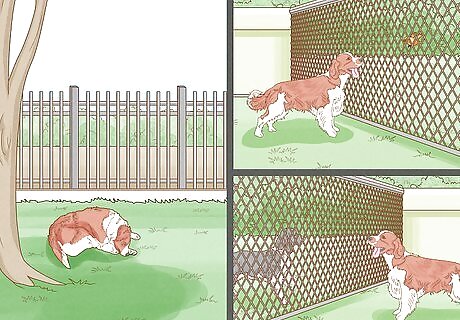
The key to solving the problem is identifying it first! Before you make any decisions on how to fix the dog’s behavior, see if you can spot causes for it. Depending on the dog’s breed and temperament, there are several reasons that they could be trying to jump the fence. The most common reason is boredom. If the dog doesn’t have enough to do inside the fence, they'll look for fun things to do outside of it. Signs that your dog may be bored include big messes, destruction of household items, and constant begging for attention. If you notice your shoes chewed or trash tipped over, your dog could be trying to tell you they don't have enough to do. If the dog isn’t neutered, he may jump the fence looking for a mate. Consider making sure your dog is neutered before letting him out in the yard unsupervised. Your dog might naturally have strong hunting instincts, and jump the fence while chasing a bird, squirrel, cat, or similar creature. If your dog has strong protective instincts or fears of certain loud noises, they could jump the fence while trying to chase away an intruder, or escape noises that trigger their fear.
Give your dog exercise.
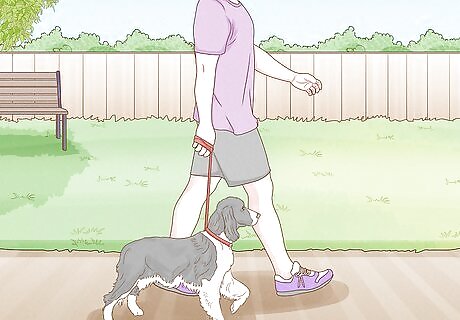
Dogs won’t jump the fence if they’re already tired. A bored and fully energized dog is far more likely to make a break for it than a dog that just got in a good helping of exercise. Take your dog for a walk, play their favorite games out in the yard, or teach them a new trick before leaving the dog to their own devices. If you tire them out with activities, then your dog will be too tired to think about jumping the fence once you leave. Generally speaking, the amount of exercise your dog needs each day will depend heavily on the dog's age and breed. In adult dogs, high-energy breeds like border collies need more exercise than low-energy breeds like pugs or basset hounds. Puppies and young dogs have more energy, which often appears in bursts of energy called the "zoomies," and usually need several short walks or play sessions throughout the day. Older dogs may not have has high a tolerance for exercising as they once did, but proper exercise each day is still critical to their health. If you’re busy, hire a dog-walker to take your pup for a spin around the block.
Keep your dog entertained in the yard.

If the yard is a playground, your pup won’t want to leave. Turn your yard into a space that is more interesting for the dog than the world outside the fence! Leave out an array of toys and balls for your dog and rotate them regularly so that the dog doesn't get bored. With enough to do at home, your dog is less likely to be tempted by the fence. Some other ideas include: Build a sandbox that your dog can dig around in. Invest in an outdoor bed, perhaps in the form of a doghouse, so that your dog has an area of their own to feel comfortable in. Give your dog plenty of time with you to ensure that they don't feel lonely.
Make a scavenger hunt for your dog.
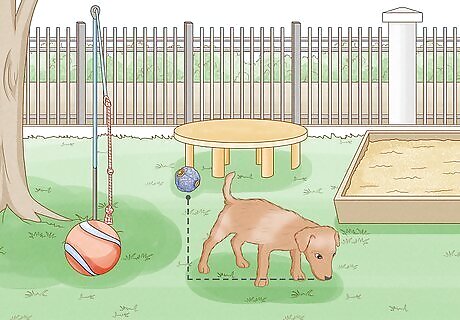
Hide treats and send your dog on a mission to find them. If you need to keep your dog busy for a while, then create a puzzle for them to solve. Stash treats around the yard in tricky places that your dog will have to reach by sniffing around and exploring. Mental stimulation is just as important (and takes up as much energy) as physical activity, so give your dog’s mind a workout and keep them interested in staying put until you’re ready to bring them back inside. If you hide the treats yourself, remember to change up hiding spots regularly to give your dog a challenge they'll enjoy indefinitely. You can also invest in a treat-dispensing machine to do the dirty work for you, and keep your dog entertained searching for treats.
Teach your dog basic commands.

If your dog knows basic commands, you can stop them from climbing. Your dog may get over excited about something and try to jump the fence, but if you spot it, you can use commands such as “come” and “stay” to both stop your dog from jumping, and reward your dog for their good behavior, so they remember it in the future. “Come” is the easier command to master, so teach your dog this one first. Make sure that, once your dog comes to you successfully, you give them lots of praise and treats! That’s how they'll learn to keep doing it in the future. “Stay” may be harder for your dog, but they'll get it in time. Hold out your hand palm-forward when you give your dog the command, as though directing traffic. Your dog probably won’t be able to sit still for long at first, but with practice and patience, they will learn to do this for longer periods and from greater distances. EXPERT TIP Sheri Williams Sheri Williams Certified Dog Trainer Sheri Williams is a Certified Dog Trainer and Behaviorist and the Owner of sheriwilliams.com, a business that specializes in teaching veterans how to turn their dogs into service dogs or emotional support animals to assist with PTSD. Based in the Los Angeles, California metro area, Sheri has over 20 years of dog training experience and also runs a general dog training practice specializing in rehabilitating dogs through positive reinforcement training techniques. She is certified by The Animal Behavior and Training Association. Sheri Williams Sheri Williams Certified Dog Trainer Actively teach the "off!" command. To stop a dog from jumping, use the body language another dog would — step into them, shoulders back, stern eye contact, firmly say "Off!" Don't back up, as that rewards the behavior. Holding your ground copies a correction from the leader dog.
Desensitize your dog to common loud noises.
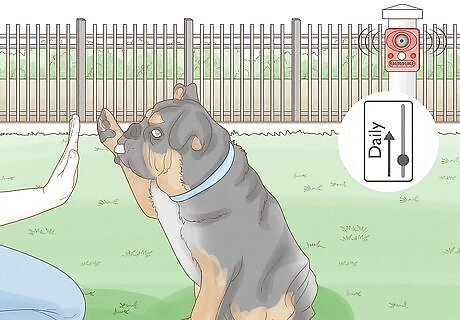
Desensitizing your dog to noises means they won’t react so strongly. If your dog’s protection instinct is flaring up and causing them to jump the fence, work on desensitizing the dog over time to common loud noises. Once your dog gets comfortable with the sounds around your home, they won’t feel the need to get nervous and chase after every random noise they may hear. Start by playing a sound or video recording of the noises that tend to trigger your dog at a low volume. When you do, make sure your dog is doing something they enjoy at the same time, like eating or playing a game. Gradually turn the volume up as your dog gets used to it. If your dog starts getting upset, just dial back the volume to a level they can tolerate and keep working on it from there. Remain calm and cheerful while you do this, so that your dog can learn that these noises are nothing to worry about. Play with your dog outside of desensitization training too, so that they don't only associate a certain game with those loud noises! Never punish your dog if they try to escape due to their fear, or separation anxiety from you; this will only make them more afraid. Instead, use the methods above to train your dog out of their fear.
Get rid of things that might help your dog climb.
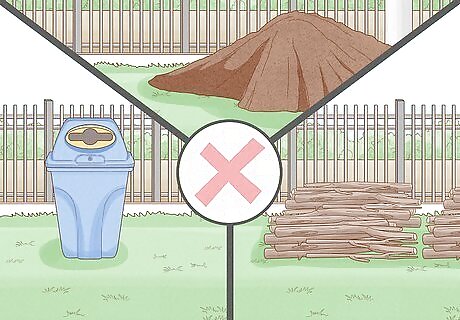
Inspect the yard for tall objects that help your dog scale the fence. Look for trash cans, wood piles, trees, yard ornaments, compost piles, and other things that might be used as a starting point when climbing the fence. Anything that could be giving the pup a leg up on their mission to scale the fence should either be eliminated, or moved to a safe place so that your dog can’t take advantage of it.
Install coyote rollers on your chain link fence.
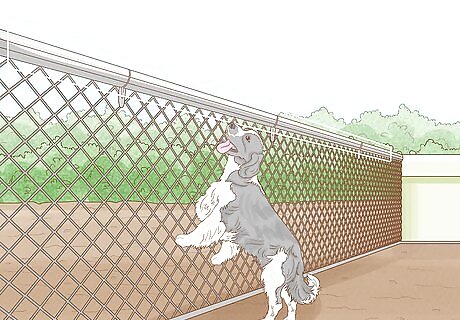
Coyote rollers keep coyotes out, but will just as effectively keep dogs in. Coyote rollers are essentially bars or piping that are attached to the top of a chain fence and roll when an animal tries to climb over them, causing that animal to fall back and making entry (and escape) impossible. If you can’t deter your dog from climbing the fence with toys, scents, exercise or extra training, then consider embellishing your fence and making it harder to climb. You can pay to have specifically-made coyote rollers installed on your chain fence, or you can build makeshift rollers yourself. To make your own coyote rollers, you’ll need a round PVC pipe and sturdy rope. “Thread” the pipe using the rope and string it horizontally along the top of your fence in places that your dog usually climbs.
Install L-footers on your chain link fence.
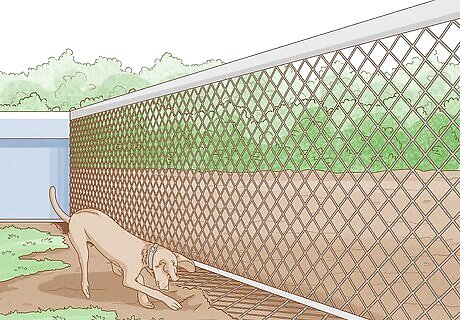
L-footers stop dogs from both climbing over and digging under the fence. If you want to cover all your bases, use L-footers. They act as angled extensions that form an “L” shape and attach to the top of the fence, making it extremely difficult for a dog to climb over. When attached to the bottom of the fence, the L-footers even be buried under the ground, and serve as a barrier to stop the dog from burrowing under the fence.
Plant obstacles along the fence.
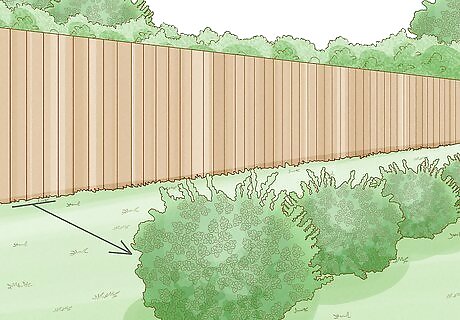
Use landscaping to your advantage. Strategically placed trees and bushes can deter your dog from climbing the fence. As a bonus, adding some new hedging can also give your yard some extra style! For example, planting a line of bushes within a few feet of the fence will stop your dog from making a full running jump onto (or over) the fence—and, once the dog realizes they can’t make the jump, they'll stop trying. When using trees and shrubs as a deterrent, pick something with dense foliage that will be difficult to pass through and impossible to climb.
Install slats or solid fencing to block the view.
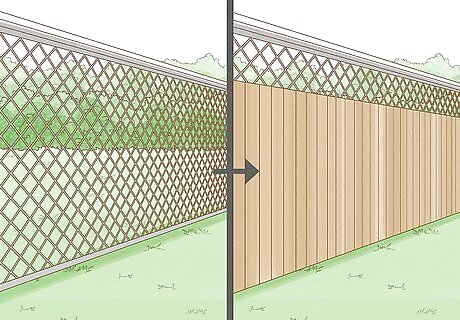
If your dog can’t see through the fence, they're less likely to jump it. A solid fence is the natural choice for this, but if you have a chain link or other type of fence that your dog can easily see through, you can attach slats or bamboo fencing to it and restrict the dog’s vision. Sounds and smells may still be an issue, but generally, if your dog can’t see through to the other side of the fence, they won’t want to climb over it so badly. Still, it’s best to only start restricting your dog’s view outside the yard when you’ve tried everything else first. Slats are thin strips of plastic that can be attached to a chain link fence to partially obscure the view from it. Bamboo fencing is less expensive than putting up a whole new fence, and can be zip-tied to your existing fence to block your dog’s view. It’ll take longer, but for a more carefully landscaped option, you could also grow vines along the fence to obscure vision through it.
Be prepared in case of an escape.

Consider using microchips, a collar ID tag, or tracking devices. It's smart to be prepared, just in case your dog gets out! At the very least, ensure that the tag on your dog’s collar has up-to-date contact information. Also consider having your dog microchipped, so that the dog can be easily identified if they are taken to an animal shelter. For a more proactive solution, a GPS tracking device for your dog’s collar can tell you exactly where they are at all times. When you purchase a GPS tracking device, make sure the one you pick has a long range and battery life. However, because GPS trackers normally rely on satellites, they’re less effective in remote areas. Make an appointment with your dog’s veterinarian to have them implanted with a microchip. It’s a very common and easy procedure, and afterwards, a microchip company will have your (and your dog’s) information on file should the dog run away and need identifying.
Keep an eye on your dog.
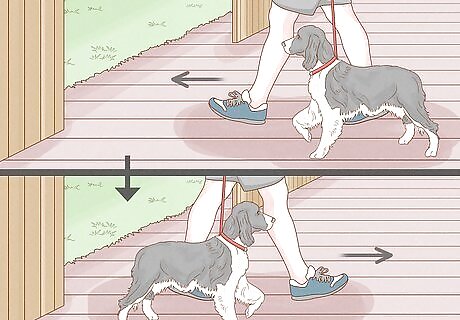
Your dog won’t jump the fence if you’re there to stop them. The easiest way to make sure your dog doesn’t jump the fence is to be there, supervising their outside time—and taking them inside when you can’t watch them at every moment. You may not be able to be present all the time, but make a habit of watching your dog as often as you can. Your dog will be far more focused on spending time with you, and you can in turn enjoy quality time with your canine best friend. Overall, if you make your yard an area of fun and excitement and spend more time there yourself, your dog will prefer to stay put instead of trying to jump away.



















Comments
0 comment